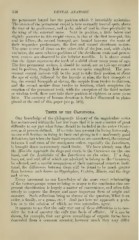Page 438 - My FlipBook
P. 438
448 DENTAL ANATOMY.
the permanent lateral has the position which it invariably maintains.
The crown of the permanent cuspid is here normally located quite above
the root of its predecessor, and at the side of and in close proximity to
the wang of the external nares. Next in position, a little below and
slightly posterior to this cuspid crown, is that of the first l)icuspid, this
and its lellow, the second bicuspid, are located between the roots of
their respective predecessors, the first and second deciduous molars.
The same is true of those on the other side of the jaw, and, with slight
variation, the same relative positions of the deciduous roots and perma-
nent crowns are observed in the inferior maxilla. It is above stated
that the figure represents the teeth of a child about seven years of age.
The first permanent molars, it should be noted, are at this age erupted
and in position, though their roots are not quite completed. The per-
manent central incisors will be the next to take their position at about
the age of eight, followed by the laterals at nine, the first bicuspids at
ten, the second bicuspids at eleven, the cuspids from twelve to thirteen,
and the second molars from twelve to fourteen, which completes the
eruption of the permanent teeth, with the exception of the third molars
or wisdom teeth, these may take their position at eighteen or some years
later. The anatomy of human dentition is further illustrated in plates
placed at the end of this paper (see p. 505).
Teeth of the Oabnivora.
Our knowledge of the philogenetic history of the unguiculate series
has so increased within the last few years that it is now a matter of great
difficulty to say just Avhat forms should be included in the order Carniv-
ora, as at present defined. If we take into account the living forms only,
no one will hesitate in fixing its limit and giving to it a moderately good
definition ; but when the fossil representatives are considered, the interval
between it and some of the contiguous orders, especially the Insedivora,
is brought down to extremely small limits. We have already seen that
the Miacidce approach the dogs and civets in the Carnirora on the one
hand, and the Lcpfididce of the Insedivora on the other. If a dog,
bear, cat, and seal, all of which are admitted to belong to the Carnivora,
be selected, and a careful comparison of their anatomical structure insti-
tuted, the differences between them will be found to be much greater
than between such forms as Styjoolophus, Ccntetes, Miacis, and the dogs
and civets.
Every increment to our knowledge of the more exact relationship
of the various groups seems to bring us nearer to the conclusion that our
present classification is largely a matter of convenience, and often fails
utterly to express the deeper and more important facts of origin and
ancestry. Such reflections bring us abreast of the question. What is an
order, a fiimily, or a genus, etc. ? And just here M'e approach a prob-
lem as to the solution of which no two naturalists agree.
It appears to me that the only way out of these difficulties is to con-
sider the test of ancestry the only true basis of aflfinity. If it can be
shown, for example, that any given assemblage of organic forms have
descended from a common ancestor, however much they may differ


